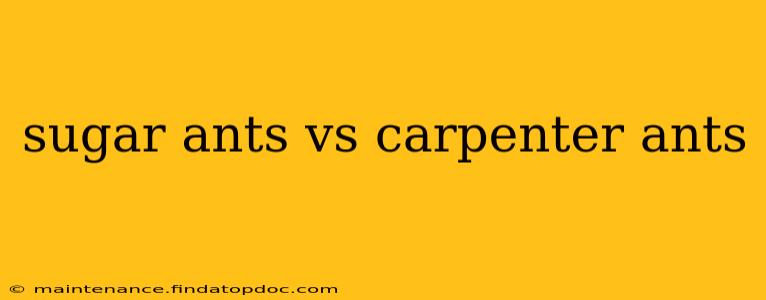Ants are a common household nuisance, but not all ants are created equal. Two species frequently invade homes are sugar ants and carpenter ants, each posing different threats and requiring different control strategies. This comprehensive guide will help you differentiate between these two common pests, understand their behavior, and effectively manage infestations.
What are Sugar Ants?
Sugar ants, often referred to as odorous house ants ( Tapinoma sessile), are small, dark brown or black ants, typically ranging from 1/16 to 1/8 inch in length. They are omnivorous, meaning they'll eat almost anything, but they have a strong preference for sweet substances like sugar, honey, syrup, and other sugary foods and drinks. This explains their common name. They are attracted to crumbs, spills, and other food sources left unattended. Identifying sugar ants often involves spotting them trailing along surfaces in search of these sweet treats.
How to Identify Sugar Ants:
- Size: Tiny, 1/16 to 1/8 inch long.
- Color: Dark brown or black.
- Behavior: Highly attracted to sweets; will form trails to food sources.
- Odor: They release a characteristic, slightly unpleasant odor when crushed.
What are Carpenter Ants?
Carpenter ants (Camponotus species) are significantly larger than sugar ants, ranging from ¼ to ½ inch long. Unlike sugar ants, which primarily feed on sweets, carpenter ants are more opportunistic feeders, consuming a variety of food sources including insects, honeydew, and other sweet substances. Their name comes from their habit of nesting in wood, but they don't actually eat the wood itself. Instead, they excavate galleries within the wood to create their nests. This can cause structural damage, especially if left untreated.
How to Identify Carpenter Ants:
- Size: Larger than sugar ants, ¼ to ½ inch long.
- Color: Variable; can be black, red, or a combination of both.
- Behavior: Less attracted to sweet foods compared to sugar ants; more likely to be found near wood.
- Damage: They create tunnels and galleries in wood, potentially causing structural damage.
Sugar Ants vs. Carpenter Ants: A Comparison Table
| Feature | Sugar Ants (Odorous House Ants) | Carpenter Ants |
|---|---|---|
| Size | 1/16 to 1/8 inch | ¼ to ½ inch |
| Color | Dark brown or black | Black, red, or a combination |
| Diet | Primarily sweets | Omnivorous; insects, honeydew, sweets |
| Wood Damage | No | Yes, creates galleries in wood |
| Odor | Distinctive, unpleasant odor | Usually no distinct odor |
What is the difference in their nesting habits?
Sugar Ants: Nest in a variety of locations, including soil, under stones, and within wall voids. Their nests are typically less organized than those of carpenter ants.
Carpenter Ants: Nest primarily in damp, decaying wood. They create intricate, well-organized galleries within the wood.
How do I get rid of sugar ants and carpenter ants?
Eliminating both types of ants requires a multi-pronged approach. For both, it's crucial to eliminate food sources. Clean up spills, crumbs, and other food debris promptly. Store food in airtight containers.
Sugar ants: Baits containing sweet substances laced with insecticides are generally effective.
Carpenter ants: Requires a more comprehensive approach, often involving professional pest control. This may include identifying and treating the nest, using insecticides, and repairing any damaged wood.
Are carpenter ants dangerous?
While not directly dangerous in the way that stinging insects are, carpenter ants can cause significant structural damage to your home if left untreated. Their nesting activities weaken the wood, potentially leading to structural instability.
Do I need to call a pest control professional?
For minor sugar ant infestations, DIY solutions might suffice. However, for significant infestations of either sugar ants or carpenter ants, particularly if you suspect nesting in your home's structure, calling a professional pest control service is advisable. They have the expertise and tools to identify the extent of the infestation and implement effective control measures.
This guide offers a comprehensive overview of sugar ants and carpenter ants. Remembering their key differences will allow for effective identification and treatment, preventing further infestations and protecting your home.
